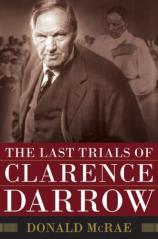The Last Trials of Clarence Darrow
Review
The Last Trials of Clarence Darrow
In the legal profession his name stands for greatness much as
the names Joe DiMaggio in baseball and John Unitas in football. He
has been portrayed on stage and screen by Orson Welles, Spencer
Tracy and Henry Fonda, to mention just a few. On a Mount Rushmore
of the legal field, Clarence Darrow’s chiseled features would
be prominent. Many biographies have been written of the great trial
lawyer as well as historical accounts of his greatest courtroom
battles. One might expect that there would be little left to cover,
yet Donald McRae’s THE LAST TRIALS OF CLARENCE DARROW is a
thoughtful and well-written examination of the final cases in an
illustrious career.
Darrow began his legal career as a corporate lawyer,
representing railroads. In 1894, he left the lucrative corporate
world to represent union leader Eugene Debs, in the Pullman workers
strike. At the same time, Darrow took on his first criminal case.
His client, Patrick Prendergast, would be convicted of the murder
of Chicago mayor Carter Harrison and executed. Fifty death penalty
cases later, Prendergast would be Darrow’s only client to
receive this ultimate punishment.
Continuing to represent notable union figures in high publicity
criminal cases, Darrow became identified with the struggles of
union workers. This portion of his career came to an end after his
representation of the McNamera brothers, who were charged with
dynamiting the Los Angeles Times Building in 1910. Although Darrow
kept the McNamera brothers from execution through a guilty plea,
the case resulted in the attorney finding himself named as a
defendant facing the accusation that he bribed a juror. After two
trials, charges were dismissed in exchange for Darrow’s
promise to leave California. It also brought to an end his
association with the trade union movement.
After this turn of events, Darrow returned to Chicago a mentally
beaten man. His legal career was at a crossroads. He would soon
find himself embroiled in the first of the three cases that are the
subjects of THE LAST TRIALS OF CLARENCE DARROW. Two of them are
among the best known in American legal history and indeed in their
time were characterized by the media as “Trials of the
Century.”
In 1924, Darrow represented Nathan Leopold and Richard Loeb, the
kidnappers and killers of 14-year-old Bobby Franks. The case had
every element necessary to guarantee front-page coverage in
newspapers around the world. Brutality coupled with thrill-seeking
criminals from wealthy families sold newspapers in the 1920s just
as similar elements fuel 24-hour news coverage in contemporary
media. McRae focuses on the key issues of the case. Darrow opposed
the death penalty and used the sentencing of Leopold and Loeb to
challenge the mindset of the 1920s that saw executions occurring on
a regular basis across the nation. He presented evidence to the
court regarding the defendants’ mental condition, arguing
that while not rising to insanity, the illness was nonetheless
sufficient to prevent execution. His closing argument to the court
lasted for days and convinced Judge John Caverly to impose a
sentence of life imprisonment.
Darrow then joined the defense of Tennessee school teacher John
Scopes, who faced charges for the offense of teaching evolution.
The scars of the Scopes trial and the issues fought in that case
remain a part of American culture 80 years after the parties
battled in a tiny courthouse in Dayton, Tennessee. Once again,
Darrow argued his case to the larger audience. Even today, one can
read his oration from the court transcripts and appreciate the
wisdom and passion of Darrow as an advocate for the causes he
supported.
The final case that closed Darrow’s career was the trial
of Ossian Sweet, a black doctor who moved his family into a white
neighborhood in Detroit. Attacked by an angry mob, Sweet fired
shots into the crowd. Darrow defended the doctor. The trial judge,
Frank Murphy, would become a justice of the U.S. Supreme Court.
Darrow’s closing argument brought the courtroom to tears, and
Sweet was ultimately acquitted of the charges.
For Donald McRae, the final trials of Clarence Darrow represent
far more than what occurred in the courtrooms of Illinois,
Tennessee and Michigan. Darrow’s last cases were trials in
the criminal sense, but Darrow himself was on trial. After his own
criminal charges in California, Darrow sought vindication of his
life’s work in these final battles. THE LAST TRIALS OF
CLARENCE DARROW is not intended to be an exhaustive biography of
this great lawyer. Instead it serves as a reminder to us all of the
passion and spirit of this relentless advocate and the battles he
fought against injustice that, even today, still exists.
Reviewed by Stuart Shiffman on December 30, 2010
The Last Trials of Clarence Darrow
- Publication Date: June 1, 2009
- Genres: History, Nonfiction
- Hardcover: 432 pages
- Publisher: William Morrow
- ISBN-10: 0061161497
- ISBN-13: 9780061161490










